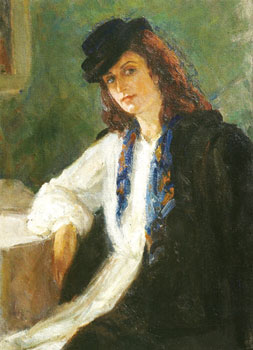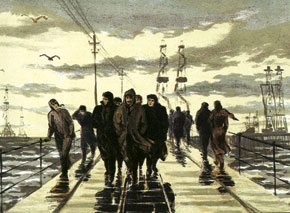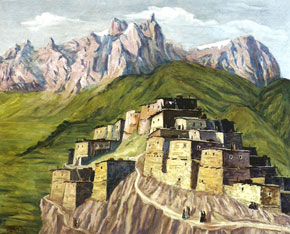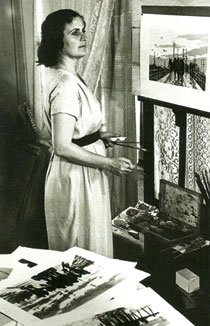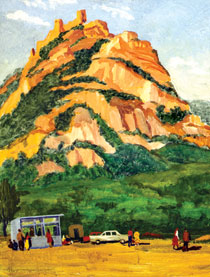Pages 76-84
by Ziyadkhan Aliyev
Enlightened ‘enemy’
Maral Rahman-zadeh (1916-2008) was born into the family of goldsmith Yusif in the Absheron village of Mardakan, and although she is now celebrated for her work with paint, her talents could have taken her in many different directions. She certainly impressed the audience who watched her play the lead in Jafar Jabbarli’s emancipation play Sevil, staged by students for the Azerbaijani State Art College’s graduation ceremony. People’s Artist Hajaga Abbasov, director of the Theatre College, who was watching the play, was amazed and wondered why she had gone in for painting rather than theatre. Thus, Maral, who graduated in 1933, was dispatched to Moscow with the blessing of College director Azim Azim-zadeh to pursue higher education. We should at this point salute the courage and foresight of Yusif kishi (Maral’s father) for giving his daughter permission to leave village life for Moscow in times when wearing the veil was obligatory; he was prepared to face the criticism that would follow. Yusif’s two sons were sculptors, one daughter was an architect, another a musician. This says something about how progressive he was. The repression of such an enlightened man in 1941 - he was branded ‘public enemy’ - must reflect on the morality of the Soviet regime. After completing her higher education, Maral started work in one of the capital’s prestigious publishing houses, but had to leave Moscow and what could have been a promising career, to return to Baku to take over household duties following her father’s arrest. As her time in higher education had a significant impact on Maral’s future work, we should take a quick glance at those days …
Very talented
She studied at the famous Moscow State Art Institute, taking lessons from the eminent artists who taught there: Lev Bruni, Dmitry Moor and Vladimir Favorski. She picked up all the nuances of artistic and technical skills and impressed Rector Igor Grabar, the famous Russian artist, restorer and art critic, as “a very talented Azerbaijani girl”. Although the young painter returned to Baku and was buried under household chores she never, for one moment, ceased her creative search and never tired of collecting new material for her future work.
In Soviet times, classicism and realism were developed into the principle of socialist realism, and this became the USSR’s dominant artistic ideology, however, many painters sought inspiration from national sources. A simple glance at Maral Rahman-zadeh’s works, with their variety of themes and genres, is enough to see how skilfully she benefited from the rich traditions of the art of the miniature, while also endowing them with her own imaginative qualities. She thus attained a very interesting unity of tradition and modernity by combining the expression of miniature painters, who viewed reality through the prism of spiritual values, and the different, highly meaningful artistic and aesthetic qualities arising from her individual views. When reviewing the painter’s seventy years of creative development, it is possible to trace a renewal of style that took place in her work. Her native Azerbaijani land and its people were the platform on which her different creative assignments were developed. Pictorial and graphic works of various themes, created throughout her life, comprise her artistic chronicle. Black and white linocuts, like Azerbaijani Woman, Then and Now (1940), On the Home Front (1942) and The Socialist City of Baku (1959-1960); colour linocuts like Our Girls and Native land, (1965-1982) and numerous pictorial images are the fine evidence.
In truth, the painter benefited mainly from her rich imagination while appealing to the past. Maral’s historical pictures delight the eye by convincingly combining the tales she heard from the elders with her fantasy and artistically mirroring pages from an often contradictory past. Her skills in depicting reality are clearly evident in her lithographs The Old City and Women’s Ensemble Dancing for Soldiers as well as in the charcoal drawings Wailing, Poverty, Unequal Marriage and others. The precise detail in these compositions underlines her wish to persuade by the realism of her depictions. Her artistic expression of the streets of Icheri Sheher (Baku’s Old City) is memorable for its seething life; a bloody Ashura commemoration conducted in the city, discrepancies in living conditions due to poverty and injustice and performers trying to raise the spirits of soldiers engaged in life and death struggles are all expertly captured in her black and white sweep.
Home front heroes
It would have been impossible for Maral Rahman-zadeh not to respond to the victory in World War II, having witnessed her compatriots’ home-front contribution. In fact the works of Azerbaijani artists of that time had already transcended borders. Thus, all artists, headed by Azim Azim-zadeh and including Maral Rahman-zadeh, were painting to inspire both soldiers and those on the home front watching anxiously as events unfolded on the battlefield. News of the productive ideological and artistic works done by Azerbaijani artists even reached the Kremlin and it was decided to exhibit them in Moscow. Thus, in spring 1943, the Moscow State Tretyakov Gallery mounted an exhibition, Works of Azerbaijani Painters during the Great Patriotic War. Cartoons drawn by Azerbaijani artists and mocking fascism were also distributed throughout the front to great psychological affect. Windows of Agitation were opened in some parts of Baku; exhibiting painters’ works on war themes, they invariably attracted a crowd. The young Maral’s On the Home Front is a series of about twenty graphics painted in charcoal and black watercolour has both historical and artistic significance. The painter ably puts across the effort and courage of people on the home front, along with their psychological strength in holding onto faith in victory: The Aerodrome, Guerrilla Girl of the Caucasus Mountains, Letter from the Front...
Images at sea…
A new theme - oil – features strongly in Maral Rahman-zadeh’s work during post-war reconstruction. As she met the oil wells nearly every day, it had been a long-held wish to give artistic representation to a natural resource which had become almost a trademark for Azerbaijan and which had contributed so much to final victory. From 1948 she worked on Oil History, consisting of ten lithograph; in those times, the acceptance by the State Tretyakov Gallery of Oil Derrick, Tanker, Oil Gusher and others for permanent exhibition was also a measure of her talent.
A year later, under the influence of that first major success, she had the idea to paint pictures showing the lives of offshore oilmen. Thus she made a creative trip to Oil Rocks, known as the eighth wonder of the World. Conditions then were not as they are now because this unique oil town was only just being built. The various authorities tried to dissuade her from a trip difficult for women. However, she insisted and in 1953 left for Oil Rocks for a long-term working trip. Maral Rahman-zadeh entered history as the first Azerbaijani painter to establish a studio in the lap of the waves. Meeting those who produced oil while struggling with the difficulties of the open sea, and tracking their work processes in unsettled weather gave her rich material for painting. Upon returning to Baku, the painter converted impressions from the trip into numerous graphic pictures. The romance of the oilmen’s labour and the tensions evoked by their working environment found their remarkable expression in such lithographs as Oil Rocks (1956-1957), On the Tanker (1954), Going on Shift (1956-1957); and in the pictures In the storm (1950s), Offshore Well (1956-1957) etc. painted in watercolours. The painter was strongly affected by Oil Rocks. She returned to this theme from time to time with a renewed and polished style and presented new variations on the theme. We could mention here her colour linocuts: Oil Tanks (1963), The Rescue Team (1963) etc. The artist replaced the black and white of her earlier works with colour in these pictures and highlighted the variable moods arising from weather changes at Oil Rocks.
.... and of her land
Maral displayed her love for her native country in a series of works called My Azerbaijan (1965-1982), capturing the special environment of each region: Lachin, Guba, Nakhchivan, Absheron, Lenkeran and Khinaliq, in paintings and graphics. Pacing every inch of the land, the painter was fascinated by what she saw and imaged a wonderful artistic impression of the touching beauty of these places, adding imaginative improvisations of her own and reflecting the diversity of the regions. She expressed the solidity and grandeur of Nakhchivan’s mountains in lithographs and the indomitable character of the houses of Khinaliq found memorable expression in her watercolours. The painter’s talent for communicating the natural environment is especially evident in Khinaliq (1963), The Kolkhoz Flock (1967), The Araz River (1964), On the Precipice (1964) and others. Maral also preserved the transparent freshness peculiar to graphics in oils: The Mountains of Lerik (1982), Lachin View (1987), Baku Bay (1960)...
Working women
Images of women feature prominently in her work, see: My Sisters and My Contemporaries. These were her artistic means of displaying Azerbaijan’s culture, customs and traditions, rich ethnography and the variety of women’s roles in life. The women in the black-and-white linocuts Returning from the Spring (1964), Highland Girls (1964) and Dance of the Lenkeran Girls (1970) and the colour linocuts Friends (1964), and Girls Picking Tea (1972) are good examples. An appealing quality of these works is the use of miniature painting traditions in forming the images, thus their delicacy, expressive outline and smooth rhythm. From these works of different mood we see that she understood the world as a flow of emotions, thoughts, spiritual joy and pain. All that she valued was generalised on the canvas as she delivered her beliefs and vision in real, precise, multilayered artistic expression.
Today when the skyline of Azerbaijan’s capital is renewed every day, we may view Maral Rahman-zadeh’s Baku series of the 1960s as a historical as well as an artistic record. The contrasts in the junction of old and new buildings, the subjects of such works as New Houses on the Upland (1960), Our Street (1950), View from the Sea (1963) and others add to their attraction.
Artistic mirror
Maral learned the fine points of book graphics during her studies in Moscow, and she contributed illustrations to a number of works of Azerbaijani and foreign fiction. The Dahnameh by Shah Ismayil Khatai; Jafar Jabbarli’s poem Maiden Tower, and his plays; the novel Sword and Pen by Mammad Said Ordubadi; poems by Fuzuli and Heyran khanim and Azerbaijani Tales as well as for Pushkin’s Eugene Onegin; and Lermontov’s Ashug Garib and Hero of Our Time all benefited from the clarity of her visions which prodded readers’ imaginations. Her design and artwork for the book Azerbaijani Women Ashugs and Poets again combined ancient and modern artistic traditions. The painter’s holding of an artistic ‘mirror’ to the words of writers of a different age shed an interesting extra angle to the work. Necessarily compact, her black and white linocuts are rich and lyrically expressive.
Maral emerged as a distinctively creative personality who made a specific artistic and aesthetic contribution. While her line had the expression of the sublime and magnificence of classical painting, her sometimes spare colouring carried the mood. Although regarded as a realist one of her positive features was that inspiration was not subordinate to reality. The events, motifs, images and gifts of nature she painted do not appear in everyday guise; they are painted as perceived by the painter and filtered through her imagination. This approach lowers the barrier between canvas and viewer and presents a poetic image.
Painting is a province in which age has no significance. Maral Rahman-zadeh was fresh and wise throughout her creative life and is rightly celebrated as a model of modern Azerbaijani painting. She was honoured: People’s Artist, the Order of Glory and laureate of the State Prize were no more than she deserved for her contribution to the nation’s visual arts.
by Ziyadkhan Aliyev
Enlightened ‘enemy’
Maral Rahman-zadeh (1916-2008) was born into the family of goldsmith Yusif in the Absheron village of Mardakan, and although she is now celebrated for her work with paint, her talents could have taken her in many different directions. She certainly impressed the audience who watched her play the lead in Jafar Jabbarli’s emancipation play Sevil, staged by students for the Azerbaijani State Art College’s graduation ceremony. People’s Artist Hajaga Abbasov, director of the Theatre College, who was watching the play, was amazed and wondered why she had gone in for painting rather than theatre. Thus, Maral, who graduated in 1933, was dispatched to Moscow with the blessing of College director Azim Azim-zadeh to pursue higher education. We should at this point salute the courage and foresight of Yusif kishi (Maral’s father) for giving his daughter permission to leave village life for Moscow in times when wearing the veil was obligatory; he was prepared to face the criticism that would follow. Yusif’s two sons were sculptors, one daughter was an architect, another a musician. This says something about how progressive he was. The repression of such an enlightened man in 1941 - he was branded ‘public enemy’ - must reflect on the morality of the Soviet regime. After completing her higher education, Maral started work in one of the capital’s prestigious publishing houses, but had to leave Moscow and what could have been a promising career, to return to Baku to take over household duties following her father’s arrest. As her time in higher education had a significant impact on Maral’s future work, we should take a quick glance at those days …
Very talented
She studied at the famous Moscow State Art Institute, taking lessons from the eminent artists who taught there: Lev Bruni, Dmitry Moor and Vladimir Favorski. She picked up all the nuances of artistic and technical skills and impressed Rector Igor Grabar, the famous Russian artist, restorer and art critic, as “a very talented Azerbaijani girl”. Although the young painter returned to Baku and was buried under household chores she never, for one moment, ceased her creative search and never tired of collecting new material for her future work.
In Soviet times, classicism and realism were developed into the principle of socialist realism, and this became the USSR’s dominant artistic ideology, however, many painters sought inspiration from national sources. A simple glance at Maral Rahman-zadeh’s works, with their variety of themes and genres, is enough to see how skilfully she benefited from the rich traditions of the art of the miniature, while also endowing them with her own imaginative qualities. She thus attained a very interesting unity of tradition and modernity by combining the expression of miniature painters, who viewed reality through the prism of spiritual values, and the different, highly meaningful artistic and aesthetic qualities arising from her individual views. When reviewing the painter’s seventy years of creative development, it is possible to trace a renewal of style that took place in her work. Her native Azerbaijani land and its people were the platform on which her different creative assignments were developed. Pictorial and graphic works of various themes, created throughout her life, comprise her artistic chronicle. Black and white linocuts, like Azerbaijani Woman, Then and Now (1940), On the Home Front (1942) and The Socialist City of Baku (1959-1960); colour linocuts like Our Girls and Native land, (1965-1982) and numerous pictorial images are the fine evidence.
In truth, the painter benefited mainly from her rich imagination while appealing to the past. Maral’s historical pictures delight the eye by convincingly combining the tales she heard from the elders with her fantasy and artistically mirroring pages from an often contradictory past. Her skills in depicting reality are clearly evident in her lithographs The Old City and Women’s Ensemble Dancing for Soldiers as well as in the charcoal drawings Wailing, Poverty, Unequal Marriage and others. The precise detail in these compositions underlines her wish to persuade by the realism of her depictions. Her artistic expression of the streets of Icheri Sheher (Baku’s Old City) is memorable for its seething life; a bloody Ashura commemoration conducted in the city, discrepancies in living conditions due to poverty and injustice and performers trying to raise the spirits of soldiers engaged in life and death struggles are all expertly captured in her black and white sweep.
Home front heroes
It would have been impossible for Maral Rahman-zadeh not to respond to the victory in World War II, having witnessed her compatriots’ home-front contribution. In fact the works of Azerbaijani artists of that time had already transcended borders. Thus, all artists, headed by Azim Azim-zadeh and including Maral Rahman-zadeh, were painting to inspire both soldiers and those on the home front watching anxiously as events unfolded on the battlefield. News of the productive ideological and artistic works done by Azerbaijani artists even reached the Kremlin and it was decided to exhibit them in Moscow. Thus, in spring 1943, the Moscow State Tretyakov Gallery mounted an exhibition, Works of Azerbaijani Painters during the Great Patriotic War. Cartoons drawn by Azerbaijani artists and mocking fascism were also distributed throughout the front to great psychological affect. Windows of Agitation were opened in some parts of Baku; exhibiting painters’ works on war themes, they invariably attracted a crowd. The young Maral’s On the Home Front is a series of about twenty graphics painted in charcoal and black watercolour has both historical and artistic significance. The painter ably puts across the effort and courage of people on the home front, along with their psychological strength in holding onto faith in victory: The Aerodrome, Guerrilla Girl of the Caucasus Mountains, Letter from the Front...
Images at sea…
A new theme - oil – features strongly in Maral Rahman-zadeh’s work during post-war reconstruction. As she met the oil wells nearly every day, it had been a long-held wish to give artistic representation to a natural resource which had become almost a trademark for Azerbaijan and which had contributed so much to final victory. From 1948 she worked on Oil History, consisting of ten lithograph; in those times, the acceptance by the State Tretyakov Gallery of Oil Derrick, Tanker, Oil Gusher and others for permanent exhibition was also a measure of her talent.
A year later, under the influence of that first major success, she had the idea to paint pictures showing the lives of offshore oilmen. Thus she made a creative trip to Oil Rocks, known as the eighth wonder of the World. Conditions then were not as they are now because this unique oil town was only just being built. The various authorities tried to dissuade her from a trip difficult for women. However, she insisted and in 1953 left for Oil Rocks for a long-term working trip. Maral Rahman-zadeh entered history as the first Azerbaijani painter to establish a studio in the lap of the waves. Meeting those who produced oil while struggling with the difficulties of the open sea, and tracking their work processes in unsettled weather gave her rich material for painting. Upon returning to Baku, the painter converted impressions from the trip into numerous graphic pictures. The romance of the oilmen’s labour and the tensions evoked by their working environment found their remarkable expression in such lithographs as Oil Rocks (1956-1957), On the Tanker (1954), Going on Shift (1956-1957); and in the pictures In the storm (1950s), Offshore Well (1956-1957) etc. painted in watercolours. The painter was strongly affected by Oil Rocks. She returned to this theme from time to time with a renewed and polished style and presented new variations on the theme. We could mention here her colour linocuts: Oil Tanks (1963), The Rescue Team (1963) etc. The artist replaced the black and white of her earlier works with colour in these pictures and highlighted the variable moods arising from weather changes at Oil Rocks.
.... and of her land
Maral displayed her love for her native country in a series of works called My Azerbaijan (1965-1982), capturing the special environment of each region: Lachin, Guba, Nakhchivan, Absheron, Lenkeran and Khinaliq, in paintings and graphics. Pacing every inch of the land, the painter was fascinated by what she saw and imaged a wonderful artistic impression of the touching beauty of these places, adding imaginative improvisations of her own and reflecting the diversity of the regions. She expressed the solidity and grandeur of Nakhchivan’s mountains in lithographs and the indomitable character of the houses of Khinaliq found memorable expression in her watercolours. The painter’s talent for communicating the natural environment is especially evident in Khinaliq (1963), The Kolkhoz Flock (1967), The Araz River (1964), On the Precipice (1964) and others. Maral also preserved the transparent freshness peculiar to graphics in oils: The Mountains of Lerik (1982), Lachin View (1987), Baku Bay (1960)...
Working women
Images of women feature prominently in her work, see: My Sisters and My Contemporaries. These were her artistic means of displaying Azerbaijan’s culture, customs and traditions, rich ethnography and the variety of women’s roles in life. The women in the black-and-white linocuts Returning from the Spring (1964), Highland Girls (1964) and Dance of the Lenkeran Girls (1970) and the colour linocuts Friends (1964), and Girls Picking Tea (1972) are good examples. An appealing quality of these works is the use of miniature painting traditions in forming the images, thus their delicacy, expressive outline and smooth rhythm. From these works of different mood we see that she understood the world as a flow of emotions, thoughts, spiritual joy and pain. All that she valued was generalised on the canvas as she delivered her beliefs and vision in real, precise, multilayered artistic expression.
Today when the skyline of Azerbaijan’s capital is renewed every day, we may view Maral Rahman-zadeh’s Baku series of the 1960s as a historical as well as an artistic record. The contrasts in the junction of old and new buildings, the subjects of such works as New Houses on the Upland (1960), Our Street (1950), View from the Sea (1963) and others add to their attraction.
Artistic mirror
Maral learned the fine points of book graphics during her studies in Moscow, and she contributed illustrations to a number of works of Azerbaijani and foreign fiction. The Dahnameh by Shah Ismayil Khatai; Jafar Jabbarli’s poem Maiden Tower, and his plays; the novel Sword and Pen by Mammad Said Ordubadi; poems by Fuzuli and Heyran khanim and Azerbaijani Tales as well as for Pushkin’s Eugene Onegin; and Lermontov’s Ashug Garib and Hero of Our Time all benefited from the clarity of her visions which prodded readers’ imaginations. Her design and artwork for the book Azerbaijani Women Ashugs and Poets again combined ancient and modern artistic traditions. The painter’s holding of an artistic ‘mirror’ to the words of writers of a different age shed an interesting extra angle to the work. Necessarily compact, her black and white linocuts are rich and lyrically expressive.
Maral emerged as a distinctively creative personality who made a specific artistic and aesthetic contribution. While her line had the expression of the sublime and magnificence of classical painting, her sometimes spare colouring carried the mood. Although regarded as a realist one of her positive features was that inspiration was not subordinate to reality. The events, motifs, images and gifts of nature she painted do not appear in everyday guise; they are painted as perceived by the painter and filtered through her imagination. This approach lowers the barrier between canvas and viewer and presents a poetic image.
Painting is a province in which age has no significance. Maral Rahman-zadeh was fresh and wise throughout her creative life and is rightly celebrated as a model of modern Azerbaijani painting. She was honoured: People’s Artist, the Order of Glory and laureate of the State Prize were no more than she deserved for her contribution to the nation’s visual arts.
